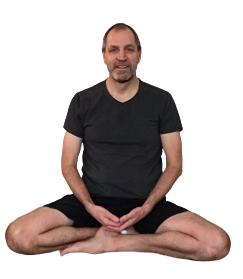Zoom class on Meditation with David Glover January 15th 2022

Twenty one people enjoyed the first CYTA yoga event of the year. David Glover’s theme was meditation.
After observing and centring the body we did some walking meditation on and off the mat, feeling the textures of the floor beneath us and remembering how lovely this is to practise outside. David mentioned he wanted to focus on opening up the chest as well as the main theme of the session as some students recovering from Covid seem to have found these movements helpful. We then warmed up with easy flowing stretches and asana sequences, such as mini standing back bends to open the chest and flat back forward bends, raising body with bent knees using legs and core muscles then onto swaying palm tree and finishing repeating back and forward bends. Slightly more stretchy cats, a super hero balance, some toe tuck postures and an optional front of feet stretch counter pose followed. A lying twist led onto a focus on bridge posture, building from a small movement to a big one then holding with chest open. We were asked to notice which muscles around buttocks, legs and core we were using and encourage them to become more engaged. A brief knees to chest rock and then we were given the option of practising the reverse table top, with or without a hold on the third try – a challenge to wrists and shoulders. A full body stretch and on to fish pose to open chest once more time and a counter pose raising chin to chest with hands behind head. I found the instructions for placement of the hands close together under the body in fish pose particularly helpful. We relaxed and observed the effects of our asana practice.
Sitting comfortably we tuned into our natural breath and were instructed to practise 3-part breathing with or without ujjayi breath. David observed the power of the warmth, comfort and healing properties of the hands resting on the body during this practice. The count was 4 in/4 hold/6 out/2 hold for each section. Five rounds, reduced to 3 for the chest area as it is more challenging for shoulders, arms (and perhaps lungs?) This was soothing, moved our awareness inwards and helped us become still in preparation for the meditation itself.
David said he had heard meditation described as a state of “relaxed alertness”, like a cat sitting next to a mousehole. He led us through a Buddhist Tonglen meditation. We focussed firstly on the top of and then the inside of the head (ajna centre) before moving down to the heart chakra. Buddhists talk about the power of connecting the rational mind and the compassion of the heart. This was an “empty vessel” visualisation. It involved imagining a replica of yourself facing you but empty inside. You transfer all you the things you don’t need to that empty vessel then cleanse with compassion your own heart and take it back. Regard your replica with compassion and wish it well using affirmations. Then direct the affirmations to yourself. May you be happy, may you be safe and well, may you be at peace. David said if anyone found visualisation difficult to simply focus on the heart space.
Smoothly moving onto relaxation we got into a comfortable position and followed a yoga nidra which was certainly new to many of us. It involved an amber liquid filling our empty body entering again from the crown of the head, noticing any tension as bubbles and then letting the amber liquid drain away.
We concluded the session chanting Om three times.
Thank you to David for leading us in an accessible and well-planned yoga class and for offering some fresh ideas for our teacher members. Thanks to CYTA for organising and thanks to the attendees.
Best practice: planning and teaching a themed, well-structured class
David’s remit for the class was Meditation. His class started with a walking meditation practise but then continued with gentle asanas. Later he explained that these were in fact part of the whole theme i.e. walking meditation and flowing asana sequences actually being forms of moving meditation. These activities were actually preparation for sitting still to practise pranayama, meditation and relaxation. Also David’s sub-theme of opening the chest physically and the heart space emotionally tied in perfectly with the main theme of his meditation which was based on self-compassion.
Overall in yoga teaching terms David provided a well-sequenced class which exemplified the role of asanas (and pranayama) as preparation for moving into stillness, meditation and relaxation and he supported the attendees to progress through the activities.
Author: Judith Lynch
Image from David Glovers website.
